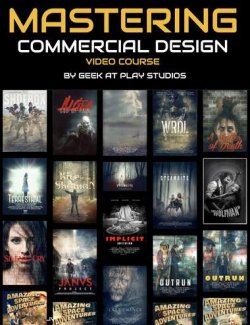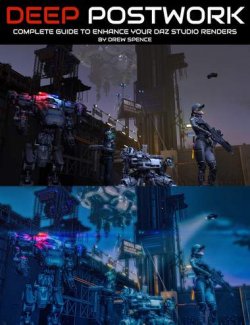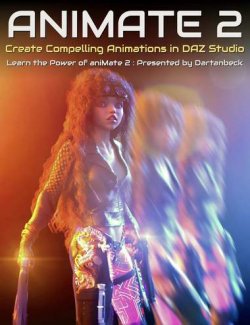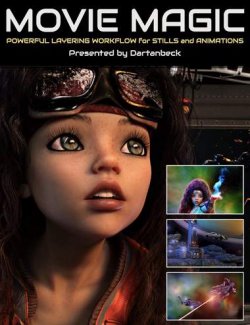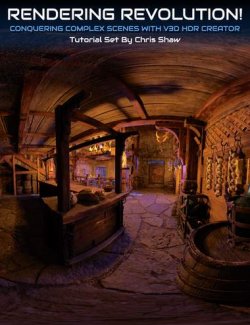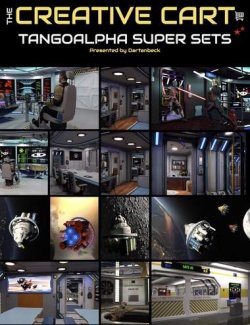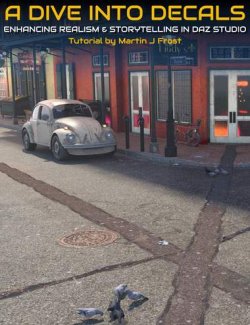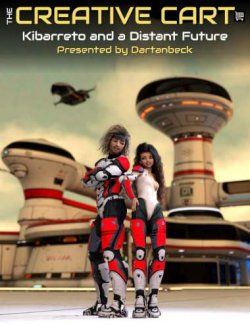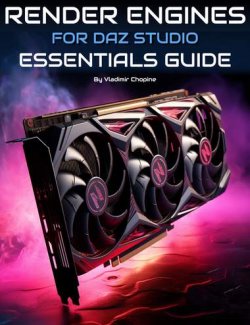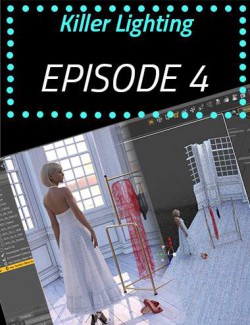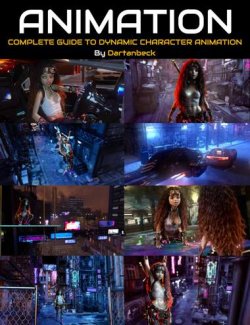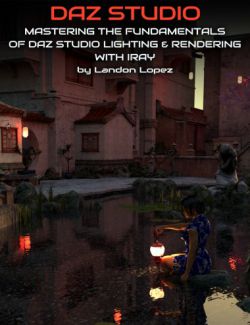Do you want to transform your ideas into mesmerizing 3D art? Do you wish to harness the full potential of Daz Studio but find its range of features overwhelming? This tutorial set provides the solution crafted with you in mind. It breaks down the complexities of Daz Studio into digestible segments. With guidance from Drew Spence, you will journey from being a Daz Studio novice to a proficient user, mastering Daz Studio with increased confidence. Discover how enjoyable and gratifying 3D creation can truly be!
Drew Spence has used Daz Studio to create hundreds of renders to publish multiple comic book series. As a result he's streamlined his workflow, hand-picked assets and curated tools that have made creating with Daz Studio faster and with less pain points along the way. Through this course, he shares his approach to creating art with Daz Studio revealing his mindset, top techniques and resources.
This tutorial product is aimed at beginners and intermediate users of Daz Studio.
Total Duration
11 hours and 22 minutes across a 9 part HD MP4 video set.
Part 1: Mindset, Daz Studio UI and Scene/Object Navigation
-
Embrace the ART Methodology: ART as a process for successful artistic creation, where "A" stands for Approach (reflecting the artist's attitude, values, and definitions), "R" for Rules (understanding the fundamentals of the medium), and "T" for Techniques (learning and applying individual components of creating the artwork).
-
Daz Studio basics and UI: Daz interface, installing and managing content, viewports and workspaces, Align, navigator, translation, scale and surface selection tools. Active pose and spot render tools, lighting basics, and cameras.
-
Master Digital Art Tools & Techniques within Daz Studio: How to maximize the use of Daz Studio by considering the organization and management of your digital content, creation of unique layouts, understanding the properties of 3D objects, and working with different types of texture maps.
-
Improve Workflow with Daz Studio Add-Ons and Techniques: Explore a suite of advanced tools within Daz Studio, such as Mesh Grabber, Active Pose, depth of field effects, texture replacement, and scripting for better control and enhanced creativity. Learn about realistic lighting simulation using iRay Engine and HDRI.
-
Maximize Daz Studio's Lighting and Rendering Features: Learn how to create professional, realistic lighting in your 3D scenes with Daz Studio's extensive lighting options. Understand the principles of lighting and apply them using light sets, dome rotation, light probes and more to achieve the desired mood and perception in your scenes.
Part 2: Customizing Characters
-
Loading a Character and Starting to Customize: Creating distinct, engaging characters while maintaining the balance of care, control, and content in your artwork. It discusses how unique characters can be designed using various features and settings, with the focus on customization for individuality.
-
Advanced Techniques and Tools for Skin Customization: Learn advanced tools and techniques, including 'Skin Builder', 'Layered Image Editor (LIE)', 'Materials Wizard', and the 'Merchant Resources', for creating realistic and unique skin textures, colors, and features for your characters.
-
Deep Dive into Costume and Prop Design: Considering 3D clothes and props with varied textures and depths, utilizing shaders and 'kit bashing'. It also offers insights into how material and color changes, unique prints or textures, and adjustments in texture tiling can create more individualized and narrative-specific character outfits.
-
Creating Realistic Scenes and Backgrounds: This training guides you through setting up realistic scenes and backgrounds, explaining how details like lighting, environment settings, HD details, and backgrounds can be adjusted for enhanced character representation, and how to solve common issues related to these settings.
-
Guidance on Advanced Artistic Techniques: The course includes advanced techniques for bettering your digital art, such as hair manipulation, adding special effects with third-party softwar and effectively using lighting and environment settings in your scenes, providing a comprehensive guide to achieving a more realistic and immersive result.
Part 3: Posing Characters
-
Master Daz Studio: Learn to operate Daz studio on three levels: technical (interface), execution (functions and features), and abstract (thinking approach). Harness the power of built-in tools and scripts to enhance your workflow, control character poses, manage lighting, and tweak render settings.
-
Develop Authentic Character Poses: Dive into the intricate art of posing, understanding the importance of details, and interaction with the environment. Use scripts and utilities to fine-tune character poses, manipulate facial expressions, and create realistic body movements. Learn how to mix and match different pose sets for unique and dynamic outcomes.
-
Master Lighting and Rendering: Explore Daz's extensive lighting features, use render presets to control quality and speed, and apply the 'IRAE Render Throttle' for varied preview settings. Use the Render Suite for advanced controls including HDR lighting and post-production adjustments.
-
Enhance Expressions and Emotions: Harness the power of complex facial expressions to change a character's mood or scene's vibe. Understand how to start from a neutral point, deal with extreme expressions, and use tools like the Expression Mixer to create nuanced and unique emotions.
-
Adopt a Creative and Analytical Approach: Understand the artistry of Daz, how attention to minute details creates expressive poses, and how mastering the mathematical aspects of pose creation can improve precision. Embrace the freedom art offers for unexpected results, and learn from studying and reverse-engineering other creators' work.
Part 4: Indoor Scene Lighting
-
Master the Art of Lighting: Understand and manipulate three types of lighting (point light, spotlight, emissive surface) in Daz Studio for realistic scenes, with focus on key elements and balance between realism and artistic vision.
-
Control Your Colors: Emphasize the critical importance of accurate monitor calibration to ensure consistent color representation across all viewing platforms and make the artwork appear as intended.
-
The Details Matter: Develop an eye for detail in set layout, prop handling, and character positioning, which can enhance scene realism and drive the narrative forward.
-
Learn through Experimentation: Adopt a hands-on approach to learning, through layering different renders, testing various light settings, and even pushing character movements beyond natural limits for specific effects.
-
Understand Your Tools: Gain comprehensive knowledge of Daz Studio's versatile tools, such as 'parenting' objects for coordinated movements, using light kits for character emphasis, and manipulating properties of scenes for dramatic impact.
Part 5: Outdoor Scene Lighting
-
Outdoor Scene Lighting Fundamentals: Learn the basics of digital art creation, from understanding the foundational principles to harnessing the pre-made resources in Daz's toolset for efficient scene creation.
-
Scene Composition: Develop skills in scene composition, exploring techniques like editing nodes, duplicating hierarchies, and using tools like geo shells for special effects.
-
Lighting and Environment Control: Gain mastery over environmental settings and lighting controls, using tools like domes, spheres, HDRI features, and manipulating light sources for desired effects.
-
Professional Rendering Techniques: Understand professional rendering techniques, such as camera functions, depth of field, tone mapping, and post-production adjustments, to enhance your artwork's quality and realism.
-
Beyond Default Settings: Learn to go beyond default settings to create unique artwork, manipulating sun and sky settings, backgrounds, and inserting props from external sources for creative control and thematic continuity.
Part 6: Lighting and IES Profiles
-
Understanding of IES profiles: a useful tool used to generate realistic and custom lighting effects, providing the ability to control light intensity, spread, color and shape in a 3D rendering scene.
-
Benefits of IES profiles: Efficiency and speed compared to other methods like emissives, making them a more resource-efficient choice for creating complex lighting effects.
-
Mood: Learn how to use lighting strategically in a scene to set the mood, highlight specific areas, and create various ambiences; lighting in interior design and its impact on behaviour in real-world environments
-
Emissive lighting and shaders: create unique effects and enhance the mood of a scene. This includes understanding the unique properties of Material Definition Language (MDL) shaders, which can provide glowing effects on objects.
-
The Light Manager Pro tool: allows for comprehensive control over the lighting within a scene, offering features like adjusting brightness, intensity, and color temperature collectively for all lights, streamlining lighting setups, and saving time in lighting management.
Part 7: Special Effects and Billboards
-
The importance of time and resources in CGI art creation, emphasizing efficient hardware and use of products to optimize rendering time and improve efficiency. It also underscores the balance between passion and resource utilization when investing in art tools.
-
in-depth insights into a variety of tools and techniques such as the use of billboards, 3D props, and 2D planes in 3D modeling. The course elaborates on methods to create realistic scenes, including the use of masking, emissive lights, IES profiles, and special effect lighting.
-
Scene preparation and post-production work. Understand how to manipulate light effects, use high-quality resources for more convincing results, and transition to post-work where specific light effects are added for greater visual impact.
-
Creativity and adaptation in Daz Studio art creation: Use of free resources, creative application of tools beyond their intended scope, and kit-bashing technique for new scene creation. It also covers camera angle experimentation and pre-planning for effects like flares or explosions.
-
Post-production enhancements. They learn about layering additional elements, manually creating effects like bloom, integrating special effects using software tools, and maintaining non-destructive saving practices. Adding textural details in post-production work for more appealing and immersive visuals.
Part 8 : Optimisation strategies in Daz Studio
-
Mastering Artistic Confidence and Validation: Learn how to navigate the intricate world of art creation and appreciation, understanding the importance of the 'awe' factor, self-confidence, and validation from peers, critics, and fans.
-
Craft vs Art, Tools and Techniques: Discover the difference between 'craft' and 'art', the intelligent use of tools, and how to turn something ordinary into extraordinary art. Understand how to balance light and speed in rendering for optimal results.
-
Optimization Strategies in Daz Studio: Explore various optimization techniques for 3D art creation in Daz Studio. Gain knowledge on using 'instances', low-resolution characters, third-party products, billboards, and composite rendering to create complex scenes without overwhelming the system.
-
Memory Management and Scene Planning: Understand how to effectively manage hard drive space and system memory while dealing with high-quality images and low-resolution models. Learn the importance of planning and scene optimization in rendering high-quality images and objects.
-
Creative Evolution through Failure and Experimentation: Embrace the power of failure, iteration, and experimentation in your artistic journey.
Sample Video
About the presenter: Drew Spence
Drew Spence has logged hundreds of hours using Daz Studio to illustrate volumes of comics, including “Force Six The Annihilators“ and "Spiderman Dynamic Plus". Drew is a graduate of Stony Brook University with a Bachelor of Arts degree in Fine Art and holds various certificates – from graphic arts to web design. Drew Spence was the CEO and Editor-in-chief of Producer’s Edge magazine, a quarterly publication dedicated to all aspects of music production. He currently lives on Long Island, New York, and produces his work from the aptly named Fallout Shelter Studios, where he crafts crafty and clever comics using CGI and photorealistic image manipulation.
What's Included and Features
- DAZ Studio Mastery Tutorial Set
- Video 1 : Mindset, UI : 1 hour 26 minutes (.MP4)
- ART comprises Approach, Rules, and Techniques (ART) - attitude, understanding the medium, and learning the craft.
- Validation comes from critics, peers, and viewers - each providing different perspectives.
- 'Talent' is the result of hard work and dedication, making complex processes seem effortless.
- The artist's signature style elicits awe and curiosity.
- The artist must balance innovation and catering to existing fans.
- Clear artistic direction provides focus for decision-making processes.
- Proficiency in DAZ Studio bridges the gap between creativity and output.
- Efficient management of digital content using DAZ Studio interface optimizes workflow.
- DAZ interface, installing and managing content,
- Selection and navigation tools
- Surface selection tools
- Lighting basics and cameras
- Using parameters and surfaces options, DAZ Studio allows control over object properties.
- Tools like Render Spots and Mesh Grabber enable precise adjustments and control.
- Active Pose tool helps to create more realistic body movements and poses.
- iRay Engine simulates light interaction for realistic renders.
- Experimenting with camera views, aspect ratios, and depth of field enhances image output.
- Scripts can be utilized to control character interactions, movements, and poses.
- HDRI provides real-world lighting simulation in a 3D environment.
- Principles of DAZ Studio lighting include realism, aesthetics, and viewer perception.
- Multiple light sets and 3D light set can be used for varied effects and broad illumination.
- Outdoor settings benefit from understanding the impact of sun positioning.
- Dome rotation and sky adjustment give more control over lighting and shadows.
- Probes offer invisible light sources for dark sets or hard-to-light places.
- The viewer's perception is crucial when creating scenes, combining real, simulated, and perceived lighting.
- "Headlamp" feature can create unnatural lighting effects; it's advised to turn it off.
- GPU rendering is more efficient than CPU rendering in DAZ, especially with NVIDIA cards.
- Video 1a (supplement) : Scripts : 19 minutes (.MP4)
- DAZ Studio's functionality can be enhanced with non-native scripts, available from external sources such as the DAZ forums.
- Downloaded scripts come as zipped files and often include a license and interface; extract these into a designated folder.
- Where NOT to install scripts.
- How to streamlining script accessibility.
- Scripts can be manually installed and accessed through the content manager, enhancing DAZ Studio scenes.
- Scripts example : "Look at Me".
- Video 2 : Customising Characters : 1 hour 37 minutes (.MP4)
- Being an artist involves clear decisions and a balance of care, control, and content.
- Care refers to the attention to the art, while control relates to mastering tools like DAZ, and content is about creating something meaningful.
- Art should tell a story, entertain, and evoke emotions, relying on the artist's talent, attitude, and relationships.
- The characters chosen by the artist can significantly influence the conveyed story, and artists can modify or create characters from scratch.
- Character customization provides uniqueness to narratives, and it is critical to give your characters identifiable features to distinguish them from standard assets.
- Customization is essential for characters that feature in multiple stories or are integral to the plot.
- Features such as skin, material, size, and shape can all be adjusted to personalize characters.
- Advanced tools like 'Skin Builder' and Genesis figure system in Daz Studio help create custom skins and realistic characters.
- DAZ Studio also allows age morphing, adjusting the character's appearance to be younger or older.
- The Layered Image Editor (LIE) allows advanced editing like tattoo application, while the Material Wizard offers a more user-friendly interface for similar adjustments.
- The third layer of character customization involves directly editing the skin, known as "perfectly imperfect skin and merchant resource," which enables further individualization.
- Textures can be edited using photo editing software and then loaded back into the character design software.
- 3D clothing design involves using shaders for varied texture and depth and applying cutout capacity to reveal underlying layers.
- The process of 'kit bashing' combines various parts of an outfit to fit a specific narrative.
- Tiling of a texture can be adjusted to fix alignment and pattern repeat issues, resulting in a seamless look.
- Hairstyles and colors also contribute to character differentiation and tone.
- An HD version of a character offers more details but requires more computer resources.
- To achieve realism, increase the lighting and the HD details.
- Backgrounds can be added to characters from online resources and adjusted to fit, enhancing depth and context.
- Levels and color balance adjustments can help characters blend better with the background.
- Hair manipulation can create more realistic or fantastical styles.
- Third-party software like Painter's Particle Shop can add special effects and details like additional strands of hair.
- Emphasis on using tools and techniques that resonate with the user and feel comfortable to use.
- Video 3 : Posing Characters : 1 hour 18 minutes (.MP4)
- DAZ Studio operates on three levels - technical, executional, and abstract, each of which requires a different approach.
- Details in character posing and interaction with the environment are critical in creating a realistic scene.
- Smart content can simplify posing but may require custom adjustments for different characters.
- Final rendering angle is important and can influence how details appear.
- Tools like Ultimate Mixer and Pose Symmetry provide greater control over character poses.
- Scripts like "Look At Me" and "Pose Splitter" enhance storytelling potential and allow for more customized posing.
- Pose manipulation is possible, but undo options may be limited, especially for whole-body adjustments.
- Some pose sets may lack a full-body reset, making blending and zeroing difficult.
- Scripts like "Look at Each Other" ensure eye contact but require proper selection of characters.
- A "null point" can correct a character's rotation axis.
- Parenting objects to the null point aids in rotation and adjustment.
- Daz's script menu can be customized for easy access to functions.
- The "Pose Fusion" utility facilitates mixing and matching poses.
- Purchased pose sets may come with additional features like symmetrical poses or body modifiers.
- Creating a specific scene may require mixing and adjusting poses.
- Controlling facial expressions can drastically change a character's mood or scene vibe.
- When creating poses, understanding weight distribution and mathematical aspects can enhance realism.
- Mastery in DAZ is achieved through reverse engineering and understanding product details.
Features like render presets and the Render Suite provide control over render quality and scene details. - The Expression Mixer tool helps create nuanced facial expressions, and resources like 'Line of Action' can provide pose inspiration.
- Attention to details like shoulder rotation and weight distribution can greatly improve the realism of character poses.
- Video 4 : Indoor Scene Lighting : 1 hour 12 minutes (.MP4)
- How monitor calibration is essential for accurate color and brightness in digital art; uncalibrated monitors can lead to inconsistencies in prints or other displays.
- Recommended calibration tools.
- Point light, spotlight, and emissive surfaces.
- How point light manipulation, including size, intensity, and positioning, significantly affects the overall scene.
- What is ray tracing and how it enhances realism.
- All about spotlights how adjustments such as intensity, color temperature, and spread angle are key.
- A realistic lighting effect requires adjustments of color and intensity settings to match the environmental lighting.
- Use lighting to emphasize key characters or elements, thereby guiding the viewer's attention and enhancing narrative.
- Emissive properties can boost illumination and contribute to scene realism.
- Complementary elements like composition, spacing, and color alongside lighting guide the viewer and contribute to the storyline.
- Using props like a flat plane can aid in shading, especially when showing maps.
- Understanding scene properties like light and color temperature balance dramatically affects the end result.
- Manually adjusting and re-parenting props can help achieve a desired look.
- Control of light intensity and source is vital for achieving the right mood and impact.
- The "three approaches to lighting" involve creating realistic lighting before experimenting with other options.
- Highlighting characters' faces, perhaps using light kits or "cheating" with a low-level spotlight, makes them stand out.
- Products like the "Ghostlight kit" allow for control over lighting aspects like positioning, color, and temperature.
Adjusting light settings like shaft length or particle spread can help achieve a particular ambiance. - Mention of 'parenting' in DAZ allows objects to follow others' movements, enhancing scene realism and dynamism.
- Video 5 : Outdoor Scene Lighting : 1 hour 29 minutes (.MP4)
- Use multiple cameras in digital art for different perspectives and duplicate them to avoid accidental changes.
- Utilize tools like editing nodes and duplicating hierarchies to manage scene composition.
- How to create visual effects like a wet or tan skin appearance.
- About using DAZ's tools and pre-made items to create art more efficiently.
- Understand the foundational process of creation to make informed choices in digital art.
- Manage your scene's lighting using tools such as domes.
- Use HDRI to render complex environments quickly on less powerful machines.
- Adjust dome rotation to ensure that light hits objects in your scene correctly.
- Render images larger than your crop to avoid overcropping.
- Don't forget to disable the auto headlamp feature.
- Use a camera and photoreal mode for the best rendering results.
- Understand and use virtual camera properties like f-stop and ISO.
- Master exposure value, which is the cumulative effect of shutter speed, f-stop, and ISO settings.
- Manipulate Depth of field (DOF) related to the f-stop to control the focus detail.
- Tweak parameters under Tone Mapping to significantly impact the final image quality.
- Improve the realism of your render by using built-in presets like a skydome.
- Adjust brightness and sensitivity of digital sensors for better detail representation.
- Experiment with film ISO and color temperature to control image colors and highlights.
- Adjust the sun's position and intensity for a desirable image glow.
- Consider the placement and design of elements to control viewer focus.
- Use Photoshop to blend multiple images for a balanced final product.
- Run multiple instances of DAZ simultaneously for continuous work while rendering.
- Video 6 : Lighting and IES Profiles : 1 hour 34 minutes (.MP4)
- IES profiles provide a high level of control for creating accurate lighting effects.
- The behavior and shape of light in IES profiles are independent of where light goes in a space.
- IES profiles render faster than emissives, offering a quick and efficient solution.
- Light measurements like Lux and Lumens are relative, not absolute, in the IES system.
- IES profiles can control light intensity, color banding, and shape, useful for stage lights.
- Applying IES profiles to light-emitting objects offers realistic lighting effects, commonly used in architecture and product design.
- Adjusting emission temperature and luminance units can significantly change the scene's lighting effect.
- Different lighting techniques can be utilized, including rim, fill, and spotlights for desired effects.
- IES profiles can replicate specific architectural lighting, which can be manipulated within a scene.
- Shaders play a vital role in the surface impact of objects, affecting the lighting of a scene.
- Strategic placement of certain lights, like ceiling or cloud lights, can enhance lighting effects.
- Tools like IES viewers allow precise control of lighting to create specific moods or effects.
- Lighting design can greatly influence the ambiance of a space, affecting customer behavior in settings like restaurants.
- IES profiles can recreate specific real-world light patterns in a virtual environment.
- Customized IES profiles can be applied to various objects to manipulate overall lighting and atmosphere.
- Adjusting the luminance value of an IES profile can alter light intensity within a scene.
- Color play in lighting can set mood variations, such as horror through a red light.
- Emissive lighting changes the overall mood and aesthetic of the scene by creating an emissive shader on a chosen object.
- Material Definition Language (MDL) shaders provide unique properties for D rendering, like glowing effects.
- A combination of IES profiles and emissive lights offers a versatile approach to scene lighting.
- Unconventional light sources can be added for dramatic effect, guiding viewer's attention.
- Different lighting tones and colors can indicate changes in scenes or character states.
- The process of lighting is iterative and requires constant adjustment to balance the scene.
- The use of tools like Light Manager Pro greatly aids in managing and adjusting lighting effects.
- Light Manager Pro provides control over brightness, intensity, color temperature, and more for all lights collectively.
- Advanced features of Light Manager Pro include switching cameras, controlling environmental modes, and manipulating drawing styles.
- Video 7 : Special Effects and Billboards : 1 hour 29 minutes (.MP4)
- Value time and invest in quality products to improve art creation efficiency.
- Leverage free CGI art resources from platforms to enhance your creations.
- Utilize your creativity to turn free resources into valuable art.
- Understand that multiple design submissions in commercial contexts such as game design can lead to better results.
- Learn how to use platforms like DAZ to streamline the creation process for complex designs.
- Utilise billboards to simulate elements like flames, saving resources and time.
- Understand how 3D props are composed and use them creatively to avoid visual repetition.
- Learn to create your own billboards using color and opacity maps for flexibility and cost savings.
- Master techniques like masking and the use of emissive lights and IES profiles to improve scene outcomes.
- Learn how to use 3D effects from various DAZ studio products and adjust them for different scene effects.
- Master the technique of kit bashing for creative scene or effect creation.
- Learn to adjust the outer glow of visual effects to maintain texture integrity.
- Master special effect lighting techniques using light sets and sub lights for depth enhancement.
- Learn to manipulate light behaviour using an IES profile for improved visual impact.
- Understand the importance of setting up scene lighting in preparation for post-work.
- Master post-work techniques like adding flares using tools like Photoshop.
- Utilize high-quality resources for sophisticated and convincing lighting effects.
- Engage with digital tool creators for insights on non-conventional uses of their tools.
- Learn the effective use of color channels and software modes like the screen mode in Photoshop.
- Pre-plan lighting in a render for adding effects and achieving scene realism.
- Experiment with different camera angles for unique perspectives and energetic compositions.
- Maintain control over scene lighting using additional tools like light packs.
- Use free or purchased resources such as images, objects, and textures responsibly.
- Master post-production techniques like adding lightning or changing exposure levels for enhanced visual impact.
- Learn to use different tools like brushes and software like Particle Shop for adding special effects to artwork.
- Video 8 : Optimisation Strategies : 58 minutes (.MP4)
- Strive for awe-inspiring art by combining aesthetics and curiosity about the creative process.
- Artistic validation comes from peers, critics, and fans.
- Confidence in your art is crucial for its progression and presentation.
- Use tools intelligently to surpass limitations and transform ordinary objects into art.
- Art distinguishes itself from craft through unique, carefully thought-out creations.
- Balance light and speed for high-quality rendering.
- Be selective in scene composition to reduce rendering time and enhance realism.
- Utilize instances (object copies) to save memory and speed up rendering.
- Instancing is beneficial for creating complex scenes with repeated elements.
- Overcome memory limitations by using low-resolution characters and instances.
- Instances are ideal for unedited objects like grass patches or distant characters.
- Low-resolution characters work well in the background or far shots in crowded scenes.
- Explore third-party products for better instance control.
- Use billboards (2D images facing the camera) to efficiently populate scenes.
- Composite rendering handles complex scenes effectively.
- Consider storage impact when using low-resolution models or billboards.
- Mix DAZ 3D characters with low-resolution figures for better performance.
- Save time and resources by using low-resolution characters and placeholder clothing in crowded scenes.
- Strategically position characters based on resolution to optimize scene quality.
- Overcome computational limitations through clever asset and tool usage.
- Convert shaders using software like the three-delight to Iray converter.
- Use Scene Optimizer to replace high memory-consuming texture maps.
- Employ hidden stage lights to influence the scene's mood.
- Plan scenes effectively to reduce rendering needs.
- Optimize scenes by adjusting resolution maps and removing unnecessary elements.
- Understand the mesh and subdivision of objects for better control.
- Balance memory and speed optimization based on priorities.
- Optimize memory by reducing texture map resolution and enabling GPU rendering.
- Create a sense of lived-in realism by adding weather, crowds, and textures.
- Embrace failure, iteration, and experimentation for artistic growth.
Install Types:
DazCentral, DIM, Manual Install

